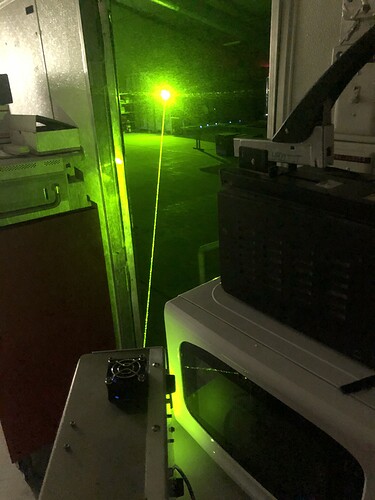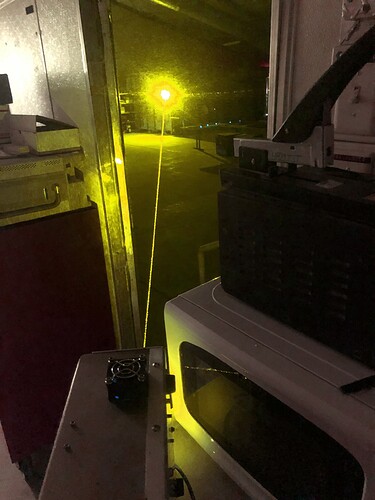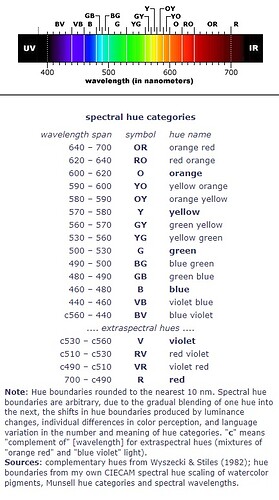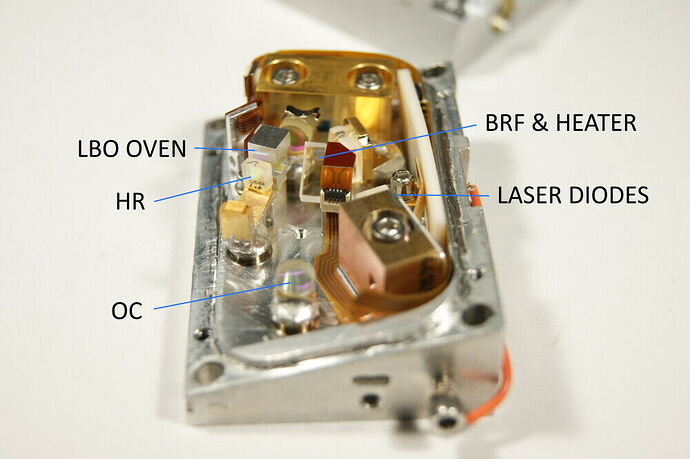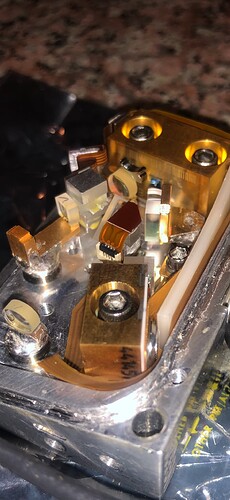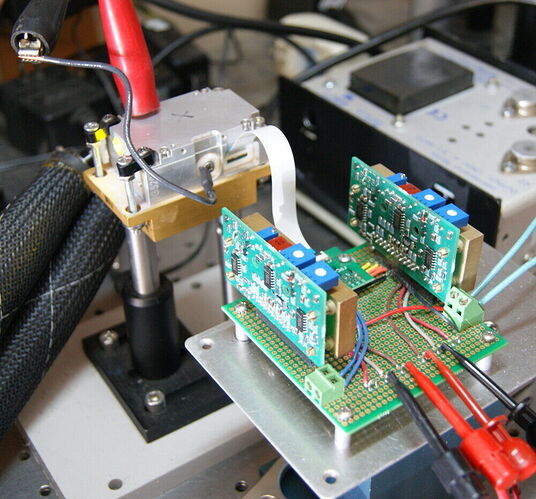I bet that too ![]()
The actual cavity inside is small enough to easily fit inside one of my big pointer hosts, thinking… but power requirements and stability may prevent such. Maybe if turned down to 1 watt. Second unit on the way for that already, don’t want to risk killing my first one which is uber stable.
Yeah, don’t wreck a perfect system for that. If you have one already planned, use that one. Just imagining a 1W portable 577. That would be amazing.
Yep, would be, but I need to study the power requirements and whether I could cool it well enough in that configuration before daring to touch the second one.
Good idea, don’t be doing a Sowee on me. (He destroys nearly every DPSS/OPSL he touches)
He has more fun taking them apart than anything else ![]()
Strange, 577 nm looks green using my iPhone camera. By eye, I can see no hint of green at all, just golden light. This photo was taken shooting out the door of my office into our warehouse area. Everyone else had gone for the day and the warehouse lights were off.
I don’t remember why digital cameras produce a green color like this when photographing a yellow laser, something to do with the RGB sensor? The other photo’s in this thread were color adjusted by the seller of the laser.
That’s it, magic. Me likes yellow ![]() I searched 30 minutes on evil google trying to find the reason that happens, best I could find is a mention of the saturation being too high for the amount of light causing the color to cross, this happens for other colors too, according to that article.
I searched 30 minutes on evil google trying to find the reason that happens, best I could find is a mention of the saturation being too high for the amount of light causing the color to cross, this happens for other colors too, according to that article.
Over saturation does seem to be a factor. Our phones have no trouble displaying yellow under normal conditions. But I think linewidth has something to do with it too. Most objects that emit yellow have large linewidths than that of a laser. I think its the same reason why our eyes don’t perceive cyan in the way that we would expect.
I hadn’t considered linewidth, hmmm… Our eyes certainly have no ability to distinguish that anywhere as narrow as these lasers produce.
I’m only speculating though. Like you said, there isn’t much available on the subject. But it could be a factor. A way of knowing would be if you had a bright yellow LED.
Maybe I shouldn’t say we cannot distinguish uber narrow line widths, if you put the beam output of a 589 nm laser next to a 577 nm the difference of color is clear, but I have some doubt whether most of us could tell the difference of 1 nm though, even if side by side. Have you any understanding on the perceivable difference between narrow linewidth wavelengths? I believe I can see 2 to 3 nm, but maybe not, need to try,
It depends on the part of the spectrum. You certainly cannot tell apart 1-2nm in the green and red portions of the spectrum. Its more like 5-10nm. However at the crossover points, cyan and yellow. 1-2nm is enough for a shift in colour. However by perception of linewidth, I mean the cameras and our eyes ability to recognise the colour by having more linewidth to process rather than distinguish between them. If we viewed a portion of the spectrum from 485-495nm I believe our eyes would view it as cyan better than if you looked at 489-491nm. The reason being, broader linewidths are more natural to what our eyes are suited for seeing. Narrow linewidths, highly polarised outputs and coherence is not what typically is found in the natural environment to observe.
Found some interesting stuff here: handprint : light and the eye
Bah, exactly where one range ends, another begins and vice versa.
I bought a nearly dead 577 nm OPSL head out of the same kind of laser here: Coherent / Iridex IQ-577 2 watt 577nm Ophthalmic laser for parts barely works | eBay
Here’s what is inside:
From the listing:
Coherent /Iridex 577nm OPSL laser from Ophthalmic laser.
This was an OPSL compact 2 Watt laser pulled from an Iridex OEM case.
Unfortunately, it is doing 62mw @ 10A. I project it will do 100mw at full power which is 12.5-13Amps.
Sold for parts, it is a dying laser and will never do the 2 watts that it used to.
I am including 2 OEM style wavelength electronic drivers on a custom board to drive the LBO and BRF resistive heaters that are already adjusted for max. output
You will receive: Dying laser head which I cracked open to study. Laser head has attached 20 pin flat cable which was really hard to install.
Board with wavelength drivers. A 30x60mm TEC which you can use with your heatsink and fan to cool the laser.
You will get all in first photo, Not included is water cooled gold heatsink seen in other photo I use for testing.
To drive this laser you will need: A 13A 2v laser driver, a driver for the tec, a heat sink and fan for the tec. A 12v power supply for the wavelength driver board.
I would love just a mW at that wl. In a way, its quite nice to have a low power one as well. As you can appreciate the wavelength more with less danger.
You didn’t get one of those 575 nm cheap modules from opt?
No, I never managed to get one.
You want one that only puts out 7 mw in a pointer? If so, I can send you one in trade for more software help later for design of parts.
